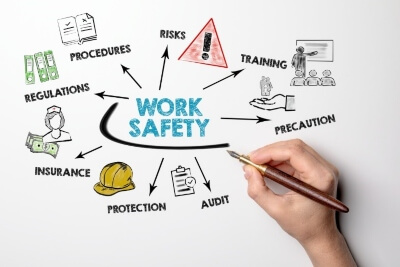As many of us in the safety business has experienced, the world of occupational health and safety can seem complex and overwhelming. There seems to be no apparent end, but instead, a continuous need to assess, implement, inform, and repeat.
While the overview of a project that needs to be completed can seem exhausting, it may largely depend on the goal.
As Orison Sweet Marden, an American inspirational author, once said:
“A good system shortens the road to the goal.”
What Orison meant by this quote is that if you have a solid system in place, it makes your goal that much more achievable.

So, what is a sound system that can help achieve our safe and compliant workplace goals? Many methodologies can be applied to create a system, but I find the following six elements, to be the most effective in creating a sound safety management system. Let’s walk through them.
Leadership
“Before you are a leader, success is all about growing yourself. When you become a leader, success is all about growing others.” – Jack Welch

Leadership is a necessary quality for anyone who wishes to inspire others to change, whether for your benefit or theirs.
Culture is the most challenging element to change in any workplace, and most challenges can be attributed to a lack of legitimate leadership. Consider the element of leadership as “leading by example” or “practicing what you preach.”
If you aren’t prepared to follow a procedure put in place, say wearing steel-toed shoes in a warehouse, how can you reasonably expect others to follow it?
Designing a procedure that you are willing to follow may often ensure that others will follow; however, be sure to view it from their side as well. Getting input from those who will be affected by this change creates a higher likelihood of buy-in.
Ultimately, we need to ensure that we have leadership in place to support our goal.
The first step of the process is meeting with those who hold a leadership role and explaining what we need to achieve. Not all leaders will be aligned with what you want to do. If not, can they provide alternative means to achieve the same goal?
As an example, let’s say we need to develop a lockout/tag-out procedure for a specific piece of equipment; we may do an assessment of that equipment and conclude that this is what we need to do; however, if we review this with the Maintenance Manager, they may say that it can’t be done because this has to be taken into consideration first.
Perhaps they can offer valuable insight into an alternative means of controlling energy that ultimately has the same result.
If so, we now have an idea in place that leadership will stand behind.
Participation
“If you want to do something that really changes someone’s life, the best thing you can do is make the person you’re trying to help a participant in the process.” – John Stahl-Wert

Safety systems cannot function properly without participation from ALL workplace parties.
Have you ever tried to implement a procedure that you like but did not receive feedback from others? I have come across this in my recent past, and I will say that it is challenging and sometimes unrealistic.
People are the most valuable asset; without people, we may not sell or build anything. So, why not use our most significant assets to provide feedback into a procedure?
If a worker provides input to a used procedure, are they more likely to follow it? The answer, in most cases, is YES.
In our workplaces, we may also have JHSC’s (Joint Health and Safety Committees), and under provincial legislation, we are required to consult with them.
As the JHSC comprises both workers and management members, they are an excellent resource to be tapped.
Hazard Identification, Assessment, and Control (HIAC)
“Thinking rationally is often different from “positive thinking,” in that it is a realistic assessment of the situation, with a view towards rectifying the problem if possible.” – Albert Ellis

No procedure can be created without first knowing what the hazards are, the risks they pose to workers, and how they will be controlled.
This is an essential element and one that exists in all methodologies used to outline workplace safety systems. The workplace safety legislation we are required by law to follow tells us that we must do this. Not knowing of a hazard’s existence is not necessarily an excuse for why it exists.
There is a need to identify the hazard and assess its severity.
It is easiest to use a template for this that will help structure the identification and assessment of a hazard; feel free to download one here.
Write down what the hazard might be, then indicate the associated risks. Once complete, assess the risk for the probability of it occurring and the severity if it were to occur.
The risk matrix will assign a risk rating if high, medium or low, which in turn provides the priority order for controls.
Once assessed, consider controls that can be implemented to either reduce the risk or eliminate it. During this portion, be sure to consult with workers and the JHSC to garner feedback on the best controls to explore.
Once you have determined the best controls, reassess them using the matrix to determine if the risk rating has changed; if it has, congratulations! If it has not changed, then other controls need to be considered.
Education
“Safety brings first-aid to the uninjured” – F.S. Huges

Education is the key to success in any business, regardless of what the subject is. In the safety world, education provides information to workers to keep them safe; safety is the ultimate goal.
Education may be done using many methods, such as quizzes, procedure reviews, formal training sessions, consulting services, etc.
Still, regardless of the method used, the goal is to provide education to workers to ensure that they stay safe during their shift so they can return home to their families at the end of the day.
Once you have determined the best possible controls, we now move to the implementation stage.
During this stage, you will need to create a documented procedure based on these controls and educate those exposed to the hazard and those who are leaders in that department.
This is the education element and is very important to get right.
We need to determine how to educate workers; will there be a presentation created? How about a quiz to confirm they understand the procedure?
Regardless of how you will educate workers, it needs to be done in a way that communicates the right message and is documented, such as a summary of the information communicated and the workers signature on an attendance form, to prove that the workers have been educated.
Evaluation
“Even worthwhile endeavors need evaluation in order to determine if they have become distractions from the best goals.” – Quentin L. Cook

Evaluating the effectiveness of our safety system is necessary to ensure that our system is effective. If we ignored our safety system, what would happen? Complacency? Lack of commitment? Lack of legal compliance? The list goes on and on.
Evaluation is a multi-tiered requirement. Not only do we need to evaluate if the workers understand and are following procedures, but we also need to evaluate the controls we put in place to ensure they are still effective and do not create more hazards.
When we put a system in place, we must continually evaluate its effectiveness; not evaluating it can lead to complacency and forgetfulness.
Evaluation involves reviewing any procedure at least annually, communicating with workers and the JHSC to reconfirm that they understand the procedure and how to follow it properly, and ensuring that leadership support continues to be upheld.
Communication
“The art of communication is the language of leadership.” – James Humes

Communication, communication, communication. This is key to most safety systems.
Without effective communication between management, workers, and supervisors, how can we effectively ensure that our system is functional and serving its intended purpose? If you ask your workers to expand on any element of the safety management system, would they be able to?
Or is it more of the pencil whipping mentality – just check off a list, so it looks complete?
Although this is one of the most significant elements, it is essential to recognize how it cannot be done without the involvement of all other factors.
A leader must take the initiative to begin the process of HIAC, Identifying, assessing and controlling hazards.
Participation is required from all parties to ensure that what is being identified, assessed and controlled is accurate and possible.
Education makes up a part of controls for every hazard as workers must be educated on how to use or work within control restraints.
All implemented controls must be evaluated to determine their continued effectiveness, but communication ensures that no further hazards are created.
Putting it all together…
When creating any policies or procedures related to safety, checking off each of the boxes above means what you developed, implemented, and maintained should be successful.
I have applied these methodical elements in many organizations and have found that the system was successful if each of the six elements were applied correctly.
Consider these six elements as a game of Jenga with only six blocks, each representing an element; what would happen if you removed any one of those blocks? Would the others fall, or would they remain unbalanced and perhaps become dislodged with the slightest nudge?
To have a solid and prosperous system, we need all the blocks in place.
Although creating a successful safety system can be a challenge, it’s essential to know two things:
- There is no such thing as perfection, only continuous improvement, and
- You are not alone
Where creating or simply maintaining a safety system becomes a daunting task, know that many resources are available to help you. If you are unsure of what step to take next, feel free to contact us, and we would be more than happy to help in any way that we can.
As Saint Francis of Assisi once said,
“Start with doing what’s necessary, then do what’s possible; and suddenly, you’re doing the impossible.” – Saint Francis of Assisi
David Ardito,
Industrial Safety Trainers Inc.





